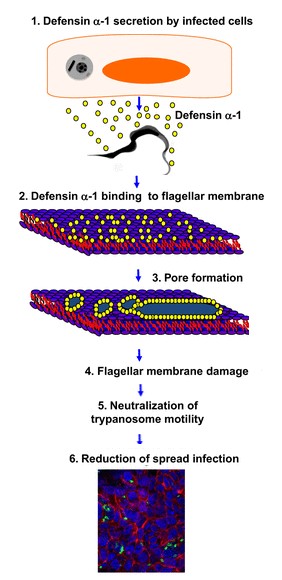Biological role
Structure
Defensin-α-1 peptides are cationic antimicrobial peptides that are synthesized in vivo as inactive precursors.
Activation requires proteolytic excision of their anionic N-terminal inhibitory pro-peptide. The pro-peptide also specifically interacts with and inhibits the antimicrobial activity of the defensin-α-1 intermolecularly.[4]
The active mature defensin-α-1 peptides consists of 29–35 amino acid residues with a molecular mass of 3–5 kDa.
The primary structure shows highly conserved residues, which are indispensable for the structural stability of the peptides. Among them are six invariant cysteine residues, necessary for the typical defensin-α-1 intramolecular disulphide-bond connectivity :
 Defensin-Alpha-1 cysteine connectivities. [5]. |
We can observe this bridge on the following figure. There are two charged amino acid residues, , forming a conserved salt bridge, and Gly17, which constitutes a signature structural motif which is essential for correct folding.
The tertiary structure is a triple-stranded β-sheet with a β-hairpin that contains cationic amino acid residue.[6].
Monomere structure
Each defensin monomer consists of three strands of antiparallel β-sheet incorporating 60% of the residues. Two β-turns and three disulfide bonds add further restrictions to the conformational freedom of the monomer.
Dimere structure
The dimere is formed by joining identical β-strands of the two monomers together to create a symmetrical six-stranded P-sheet. This extended β-sheet twists and curls to form a basket-shaped structure that has a small slolvent-accessible channel passing through it. The base of the basket is hydrophobic while the top, which contains the N- and C-termini of the two defensin monomers, is polar. In the crystal structure, two dimers associate with one another by hydrophobic contact between the bases of each dimer basket. This dimer-of-dimers may be an essential feature of defensins’interaction with membranes.
Example
DEF are known to play a role in the in the initiation of innate immune responses to some microbial pathogens. They are antimicrobial peptides of innate immunity functioning by non-specific binding to anionic phospholipids in bacterial membranes. For example defensins-α-1 have a role against the bacteria Trypanosoma cruzi.
[7].Trypanosoma cruzy or Cruzy debilitats Chagas disease, which affects millions of people and products significant morbidity and mortality. The defensine-α-1 are secreted by the HCT116 cells (which are Paneth cells), when they are infect by Cruzy. They reduces the infection making damage of the flagella structure. This damage inhibit parasite motility and reduce cellular infection. This reaction is introduce in the following drawing.
References
- ↑ http://www.ncbi.nlm.nih.gov/gene/1667
- ↑ Abraham L. Kierszenbaum. Histologie et biologie cellulaire: Une introduction à l'anatomie pathologique 2002
- ↑ http://www.reactome.org/PathwayBrowser/#DIAGRAM=1461973&PATH=168256,168249
- ↑ www.ncbi.nlm.nih.gov/pmc/articles/PMC2754386/ )
- ↑ Stephen H Wile, William C Wimley and Michael E Selsted. Structure, function, and membrane integration of defensins. Current Opinion in Structural Biology 1995. University of California, Irvine, USA
- ↑ http://www.ncbi.nlm.nih.gov/pmc/articles/PMC2049026/
- ↑ http://iai.asm.org/content/81/11/4139.full/ref
Proteopedia page contributors and editors


